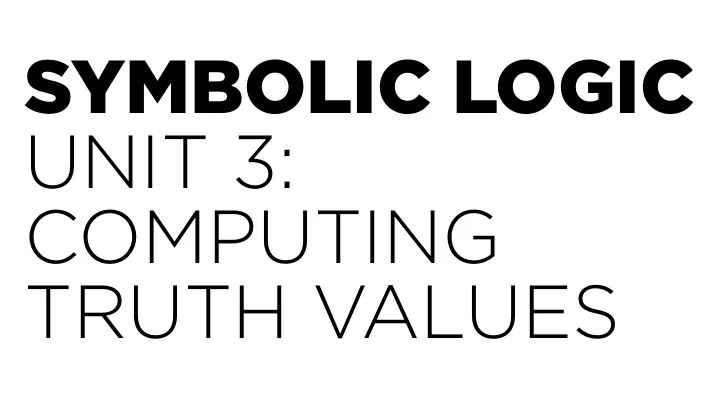

SYMBOLIC LOGIC UNIT 3: COMPUTING TRUTH VALUES
Truth Values The truth value of a formula/sentence is always (at least in this class) either true (T) or false (F). Notes: Truth values has nothing to do with how valuable a sentence is. “Truth value” is a technical term, which derives from the mathematical concept of the value (output) of a function.
Truth-Functional Operators If an operator is truth functional, then we can determine the truth value of any formula in which it is the major operator just by knowing the truth values of its most complex subcomponent formula(s). In particular: If all of the operators in a compound sentence are truth functional, then the truth or falsity of this sentence can always be determined just by knowing the truth or falsity of its component parts.
Truth-Tables If a sentential operator is truth-functional, then we can easily compute the truth value of any formula in which it is the major operator if we know the truth values of its parts.
NEGATION ~ p p T F F T CONJUNCTION DISJUNCTION CONDITIONAL BICONDITIONAL ( p • q ) ( p ∨ q ) ( p ⊃ q ) ( p ≡ q ) p q p q p q p q T T T T T T T T T T T T T F F T F T T F F T F F F T F F T T F T T F T F F F F F F F F F T F F T
CONJUNCTION ( p • q ) p q T T T T F F F T F F F F
DISJUNCTION ( p ∨ q ) p q T T T T F T F T T F F F
BICONDITIONAL ( p ≡ q ) p q T T T T F F F T F F F T
NEGATION ~ p p T F F T
CONDITIONAL ( p ⊃ q ) p q T T T T F F F T T F F T
How to Compute Truth Values (A • X) ∨ (B • Y)
T F T F (A • X) ∨ (B • Y) Step 1: write the truth values for the simple components above them.
T F T F (A • X) ∨ (B • Y) F F Step 2: write the truth values of the simplest subformulas beneath their major operators. Use arrows to represent dependencies.
T F T F (A • X) ∨ (B • Y) F F F Step 3: Continue down the tree until you get to the major operator.
SYMBOLIC LOGIC UNIT 4: SYMBOLIZING ENGLISH SENTENCES
“Since we have only the five operators and since English is an extremely rich and complex language, with any number of ways of forming compound sentences, there will necessarily be a fair bit of “squeezing” involved to get the English to fit our simple logical language. Something, sometimes a good bit, is bound to be lost in translation.” —Klenk, pp.51–52
Steps for Symbolizing in Sentential Logic 1. Identify the simple sentences and operators. 2. Determine which of the operators are truth functional. 3. Identify the major operator. • If it is truth functional, replace it with the relevant symbol. • If not, represent the whole sentence as a single letter. 4. Continue step 3 for subformulas.
antecedent consequent p ⊃ q CONDITIONAL ( p ⊃ q ) p q T T T sufficient for T F F F T T F F T necessary for
Four versions of ⊃ in English if only if provided that unless
Four versions of ⊃ in English You’ll pass the course. ≡ P You’ll learn logic ≡ L 1. You’ll pass the course if you’ll learn logic. 2. If you’ll pass the course, you’ll learn logic.
Four versions of ⊃ in English You’ll pass the course. ≡ P You learn logic ≡ L 1. You’ll pass the course only if you learn logic. 2. Only if you’ll pass the course will you learn logic.
Four versions of ⊃ in English You’ll pass the course. ≡ P You learn logic ≡ L You’ll pass the course provided that you learn logic. Provided that you pass the course, you’ll learn logic.
Four versions of ⊃ in English You’ll pass the course. ≡ P You learn logic ≡ L You’ll pass the course unless you learn logic. Unless you pass the course, you’ll learn logic.
Recommend
More recommend